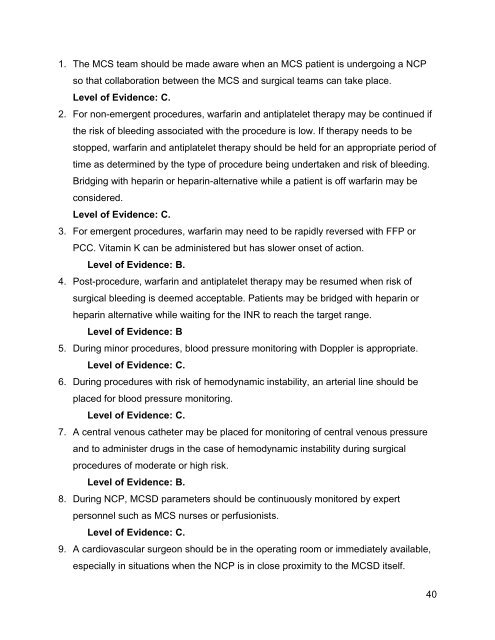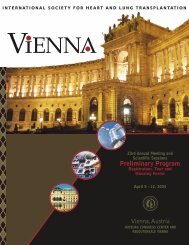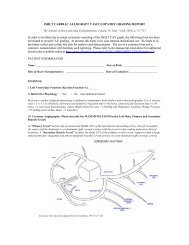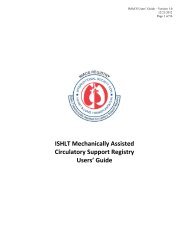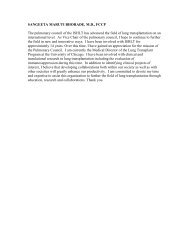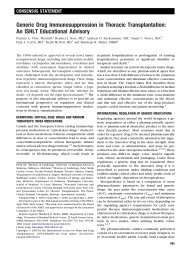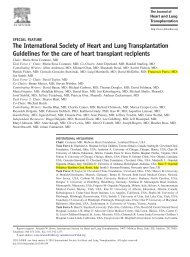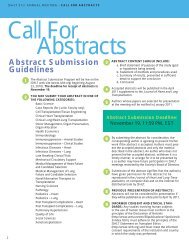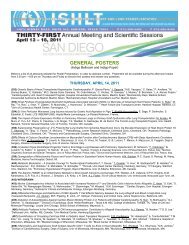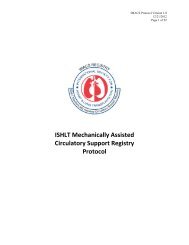Task Force 4: Inpatient Management of Patients with MCSD - The ...
Task Force 4: Inpatient Management of Patients with MCSD - The ...
Task Force 4: Inpatient Management of Patients with MCSD - The ...
You also want an ePaper? Increase the reach of your titles
YUMPU automatically turns print PDFs into web optimized ePapers that Google loves.
1. <strong>The</strong> MCS team should be made aware when an MCS patient is undergoing a NCP<br />
so that collaboration between the MCS and surgical teams can take place.<br />
Level <strong>of</strong> Evidence: C.<br />
2. For non-emergent procedures, warfarin and antiplatelet therapy may be continued if<br />
the risk <strong>of</strong> bleeding associated <strong>with</strong> the procedure is low. If therapy needs to be<br />
stopped, warfarin and antiplatelet therapy should be held for an appropriate period <strong>of</strong><br />
time as determined by the type <strong>of</strong> procedure being undertaken and risk <strong>of</strong> bleeding.<br />
Bridging <strong>with</strong> heparin or heparin-alternative while a patient is <strong>of</strong>f warfarin may be<br />
considered.<br />
Level <strong>of</strong> Evidence: C.<br />
3. For emergent procedures, warfarin may need to be rapidly reversed <strong>with</strong> FFP or<br />
PCC. Vitamin K can be administered but has slower onset <strong>of</strong> action.<br />
Level <strong>of</strong> Evidence: B.<br />
4. Post-procedure, warfarin and antiplatelet therapy may be resumed when risk <strong>of</strong><br />
surgical bleeding is deemed acceptable. <strong>Patients</strong> may be bridged <strong>with</strong> heparin or<br />
heparin alternative while waiting for the INR to reach the target range.<br />
Level <strong>of</strong> Evidence: B<br />
5. During minor procedures, blood pressure monitoring <strong>with</strong> Doppler is appropriate.<br />
Level <strong>of</strong> Evidence: C.<br />
6. During procedures <strong>with</strong> risk <strong>of</strong> hemodynamic instability, an arterial line should be<br />
placed for blood pressure monitoring.<br />
Level <strong>of</strong> Evidence: C.<br />
7. A central venous catheter may be placed for monitoring <strong>of</strong> central venous pressure<br />
and to administer drugs in the case <strong>of</strong> hemodynamic instability during surgical<br />
procedures <strong>of</strong> moderate or high risk.<br />
Level <strong>of</strong> Evidence: B.<br />
8. During NCP, <strong>MCSD</strong> parameters should be continuously monitored by expert<br />
personnel such as MCS nurses or perfusionists.<br />
Level <strong>of</strong> Evidence: C.<br />
9. A cardiovascular surgeon should be in the operating room or immediately available,<br />
especially in situations when the NCP is in close proximity to the <strong>MCSD</strong> itself.<br />
40


